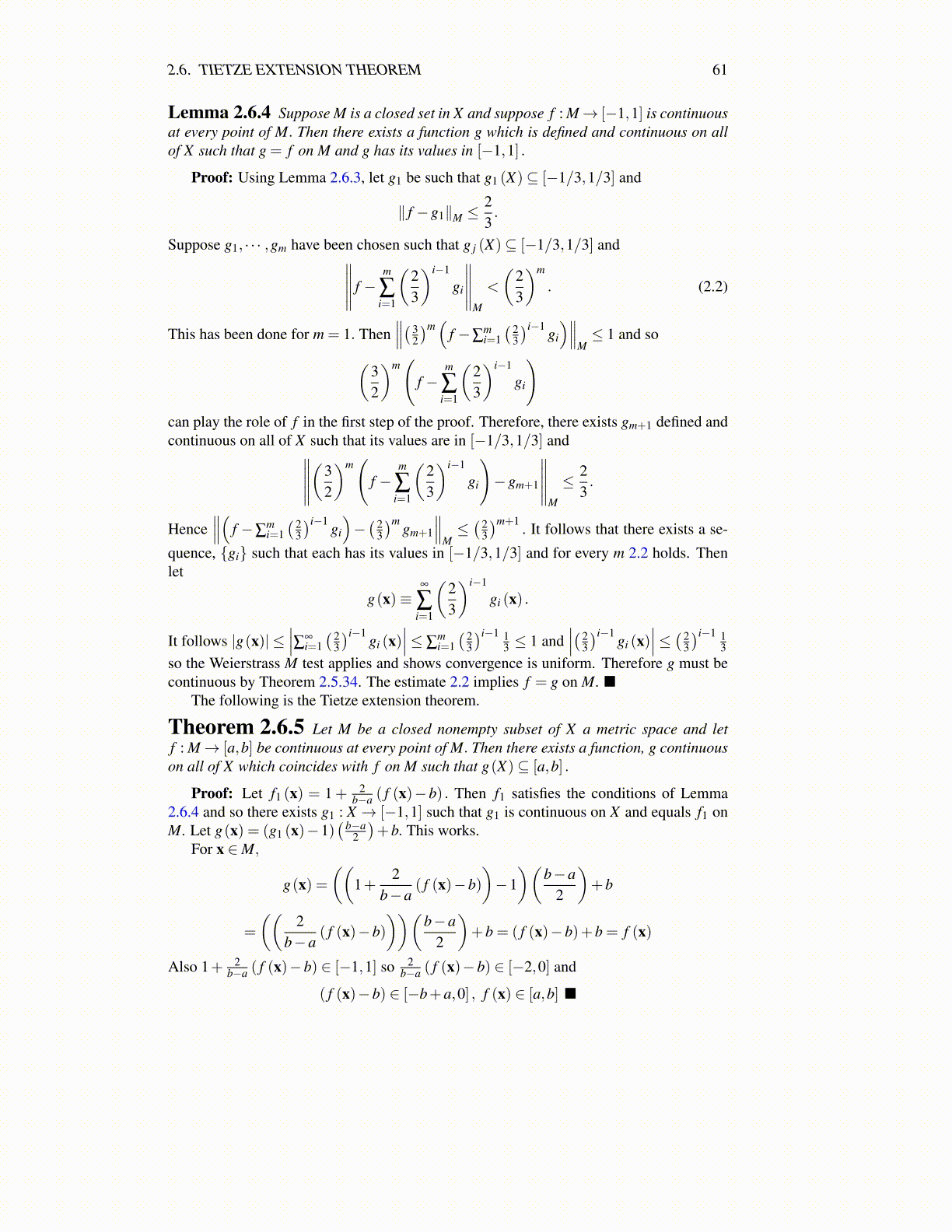
2.6. TIETZE EXTENSION THEOREM 61
Lemma 2.6.4 Suppose M is a closed set in X and suppose f : M→ [−1,1] is continuousat every point of M. Then there exists a function g which is defined and continuous on allof X such that g = f on M and g has its values in [−1,1] .
Proof: Using Lemma 2.6.3, let g1 be such that g1 (X)⊆ [−1/3,1/3] and
∥ f −g1∥M ≤23.
Suppose g1, · · · ,gm have been chosen such that g j (X)⊆ [−1/3,1/3] and∥∥∥∥∥ f −m
∑i=1
(23
)i−1
gi
∥∥∥∥∥M
<
(23
)m
. (2.2)
This has been done for m = 1. Then∥∥∥( 3
2
)m(
f −∑mi=1( 2
3
)i−1gi
)∥∥∥M≤ 1 and so(
32
)m(
f −m
∑i=1
(23
)i−1
gi
)can play the role of f in the first step of the proof. Therefore, there exists gm+1 defined andcontinuous on all of X such that its values are in [−1/3,1/3] and∥∥∥∥∥
(32
)m(
f −m
∑i=1
(23
)i−1
gi
)−gm+1
∥∥∥∥∥M
≤ 23.
Hence∥∥∥( f −∑
mi=1( 2
3
)i−1gi
)−( 2
3
)mgm+1
∥∥∥M≤( 2
3
)m+1. It follows that there exists a se-
quence, {gi} such that each has its values in [−1/3,1/3] and for every m 2.2 holds. Thenlet
g(x)≡∞
∑i=1
(23
)i−1
gi (x) .
It follows |g(x)| ≤∣∣∣∑∞
i=1( 2
3
)i−1gi (x)
∣∣∣≤ ∑mi=1( 2
3
)i−1 13 ≤ 1 and
∣∣∣( 23
)i−1gi (x)
∣∣∣≤ ( 23
)i−1 13
so the Weierstrass M test applies and shows convergence is uniform. Therefore g must becontinuous by Theorem 2.5.34. The estimate 2.2 implies f = g on M. ■
The following is the Tietze extension theorem.
Theorem 2.6.5 Let M be a closed nonempty subset of X a metric space and letf : M→ [a,b] be continuous at every point of M. Then there exists a function, g continuouson all of X which coincides with f on M such that g(X)⊆ [a,b] .
Proof: Let f1 (x) = 1+ 2b−a ( f (x)−b) . Then f1 satisfies the conditions of Lemma
2.6.4 and so there exists g1 : X → [−1,1] such that g1 is continuous on X and equals f1 onM. Let g(x) = (g1 (x)−1)
( b−a2
)+b. This works.
For x ∈M,
g(x) =((
1+2
b−a( f (x)−b)
)−1)(
b−a2
)+b
=
((2
b−a( f (x)−b)
))(b−a
2
)+b = ( f (x)−b)+b = f (x)
Also 1+ 2b−a ( f (x)−b) ∈ [−1,1] so 2
b−a ( f (x)−b) ∈ [−2,0] and
( f (x)−b) ∈ [−b+a,0] , f (x) ∈ [a,b] ■